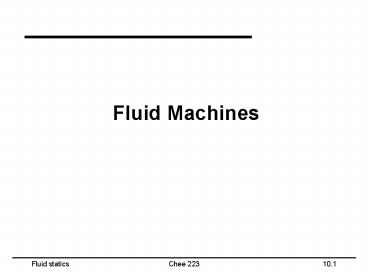Fluid Machines - PowerPoint PPT Presentation
1 / 10
Title:
Fluid Machines
Description:
... example is the centrifugal pump. Turbines extract energy ... Centrifugal Pump ... In centrifugal pumps, the fluid must be brought up to the rotational speed of ... – PowerPoint PPT presentation
Number of Views:349
Avg rating:3.0/5.0
Title: Fluid Machines
1
- Fluid Machines
2
Fluid machines
- Pumping machines add energy to a fluid
- Examples Pumps (for liquids), fans, blowers and
compressors (for gases) - Positive-displacement machines a finite volume
of liquid is drawn into a chamber and then forced
out under high pressure. - Turbomachines Energy is added to the fluid by
means of a rotating impeller. A common example is
the centrifugal pump. - Turbines extract energy from the fluid.
6.48
3
Positive Displacement Pump
- Works on the principle of letting fluid flow into
a cavity from a low-pressure source, trapping the
fluid, and forcing it out to a high-pressure
receiver by decreasing the volume of the cavity - Simplest pump that can be found anywhere from
liquid soap dispensers, to automobile fuel
injectors, to the human heart.
4
Centrifugal Pump
- Based on the concept of increasing the kinetic
energy via the centrifugal action of the impeller
and converting this kinetic energy to work - Used predominantly for high-flow applications,
less expensive, and less complex thereby
minimizing maintenance - Must be pre-charged with liquid or else it wont
pump at start-up. Positive displacement pumps
dont have this limitation.
5
(No Transcript)
6
Centrifugal Pump Curves
- Pumps from manufacturers are typically rated by
the amount of fluid work that can be achieved as
a function of fluid flow - Fluid work in the pump curves is typically
expressed in head form - Work decreases with increasing flow due to
increased losses incurred at higher flow
velocities
Theoretical pump curve
7
Pump Operating Curves
8
NPSH Net Positive Suction Head
- In centrifugal pumps, the fluid must be brought
up to the rotational speed of the impeller
blades. - Increasing the fluid velocity would result in a
decrease in pressure - This can cause boiling of the fluid or cavitation
around the eye of the impeller. - To prevent this, there must be elevation of the
fluid before the pump.
9
NPSH Net Positive Suction Head
- This height is known as the net positive suction
head (NPSH). - The NPSH for a pumping system can be found
theoretically using B.E.
- The velocity at the eye of the impeller is the
vector sum of the rotational velocity at that
point and the radial velocity (see Example 10.6) - In practice the NPSH can be found from the Pump
Map (NPSHR where R stands for required).
10
NPSH Net Positive Suction Head
- The NPSH calculated above was only for the pump,
it did not take into account friction losses
prior to the pump. - The additional NPSH can be calculated as
- The total NPSH can be found by adding these two
hs together. - If the actual height, h, is greater than the sum,
then the pump should run smoothly. Otherwise
cavitation can occur resulting in poor
performance and damage to the pump. - If insufficient height is available, special
centrifugal pumps with low NPSHR or P.D. pumps
may be used.

